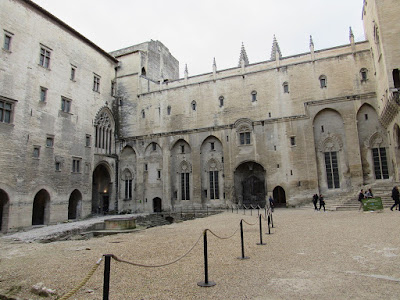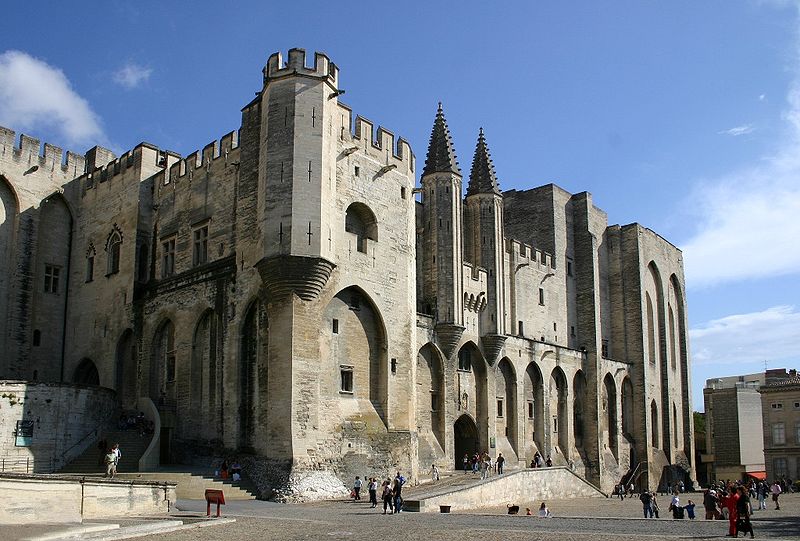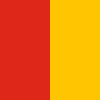In 1309 political unrest in Rome forced Pope Clement V to move the papal court to a small town in France called Avignon.
Built over the demolished episcopal palace, construction of the papal palace began in 1335 and was completed in less than 20 years. Actually, the palace is the amalgamation of two palaces built by two popes: Benedict XII (1334-42), who built the simple Old Palace to the east and north, and his successor Clement VI (1342-52) who built the more flamboyant New Palace to the south and west.
The palace became the papal residence and seat of Western Christianity during most of the 14th century. It also represented a change in the general organization of the Church by centralizing services and adapting its operations to new and evolving needs. By 1316, the Curia (Church administration) increased from 200 to 500 priests and bishops, and over 1,000 lay officials.
Avignon Papacy
1309–1378/1437
1309–1378/1437
Six papal conclaves were held in the palace, leading to the elections of Benedict XII in 1334, Clement VI in 1342, Innocent VI in 1352, Urban V in 1362, Gregory XI in 1370 and Anti-pope Benedict XIII in 1394.
The palace boasts 160,000 square feet of floor space and is the largest and one of the most important Gothic palaces in the world because of its many architectural merits, according to Eugène Emmanuel Viollet-le-Duc (1814–79), author of Dictionary of French Architecture from the 11th to the 16th Century. These merits include the thickness and height of its towers, the strength of its crenelated walls, the use of arcs for support on its façades--and its ability to withstand heavy and drawn-out sieges. In truth, the palace looks more like a fortress than a palace with parapets, an aura of impregnability, and ten towers, some of which are more than 164 feet high. The design of the palace reflects the insecure tenor of the times for religious life.
Among the surprising characteristics that distinguish the palace for me were the immensity of the rooms, the appreciation for art, and its colors. To get an idea of what the palace looked like in its day, visitors are given a "histopad," an iPad-like device that not only provides computerized images of various rooms, but historical explanations of their use. Here are photos and explanations of a few of the 25 rooms open to the public through a self-guided tour.
 In Consistory Hall the pope convened meetings with cardinals, received sovereigns and ambassadors, held public audiences, and announced new cardinals. A fire in 1413 destroyed the painted decorations in this hall; the reddish discoloration of the stone indicates the enduring effects of the fire.
In Consistory Hall the pope convened meetings with cardinals, received sovereigns and ambassadors, held public audiences, and announced new cardinals. A fire in 1413 destroyed the painted decorations in this hall; the reddish discoloration of the stone indicates the enduring effects of the fire. 
This computerized image shows how the room was set up. The pope is seated in the center in the back of the photo.
Another computerized image shows what the ceiling might have looked like.
The Treasury was a sealed room with slits for windows and iron bars on them. Silver and gold pieces were kept here as well as ornaments and title deeds. Only the pope, the papal chamberlain, and the treasurer were allowed in the Treasury Room that was continuously guarded. Five clerks and a number of notaries, couriers, and scribes were also part of the team.

Registers of accounts, coins, valuables, and documents were kept in chests like these and placed under paving stones built below the floor.

Saint Martial Chapel was decorated with some brilliantly-colored frescoes by Matteo Giovannetti and his team in 1344-45. The pope and his assistant used this small chapel on non-feast days and weekdays. Soldiers badly damaged the chapel in the 19th century. Over the centuries, deterioration has left the chapel in fragile condition with much more restoration to come.
The chapel was dedicated to St. Martial who was sent by St. Peter to preach the Gospel in the Limousin region in southcentral France. The fourth Avignon Pope, Clement VI, was born in this region. He symbolically moved the saint's feast day to July 7 and ordered the Divine Office to be used from the readings and prayers of the apostles. In this way, Martial, the "new St. Peter", was deemed to give a certain legitimacy to Avignon as the new capital of Christianity and the French popes.
The Chapel of St. John was used for shorter Masses and reduced audiences. It now displays various artifacts of the palace.

Courtyard between the Old and the New Palaces
Cupboard doors
Frescoes in the Lower Hall with a small remnant of a Crucifixion scene below it.

 The Grand Tinel was a 157.5-foot room used for papal feasts. Banquets were held on main feast days or in celebration of men promoted to cardinal. A feast generally comprised 5 sittings with four different courses.
The Grand Tinel was a 157.5-foot room used for papal feasts. Banquets were held on main feast days or in celebration of men promoted to cardinal. A feast generally comprised 5 sittings with four different courses. The papal cathedra was placed on a platform on one side topped by a canopy. The pope would eat there alone. Cardinals, prelates and other guests sat on benches along the main walls. Meals were served from the center. The master of the hall, the butler, pantler (bread server), the maître de l'eau (water bearer), and several other servants were there ready to act. The écuyer tranchant (cutting squire) cut the food, which was carefully laid on precious chinaware.

The dishes were kept warm in the fireplace (reconstructed).
An ornate door leading to the Grand Chapel
The Grand Chapel is 66 feet high and covers an area of 8,400 square feet. Art exhibits are held here during the summer.



Remnants of a fresco in the Grand Chapel.

Statuary is now kept in the North Sacristy.
 The
palace incorporated cloisters into its design, which was
considered new and different for a cathedral building. A cloister is a covered walkway or open arcade running along the walls of a building. It was a device used in monasteries to separate monks from the serfs or workmen who lived and worked outside or around the cloister.
The
palace incorporated cloisters into its design, which was
considered new and different for a cathedral building. A cloister is a covered walkway or open arcade running along the walls of a building. It was a device used in monasteries to separate monks from the serfs or workmen who lived and worked outside or around the cloister.The pope's seal flanked by some cute, chubby angels
Pointed stained glass windows with quadre-foils (4-sides) and octo-foils (8-sides) helped to bring in more light and support for the structures so that ceilings could be raised higher. Towering Gothic cathedrals symbolized humanity reaching toward God.

Palm tree columns located in the Lower Treasury as well as the Grand Chapel.

The staircase is wide with windows fitted along its slope. It was considered an architectural innovation and believed to be the first staircase in the Italian style in France. It was repaired in 1659.

Tiles from one of the rooms. Green and brown ceramic was particularly popular in southern France.

Keys to the palace

Some interesting old doors in the palace courtyard of no particular significance.
The massive walls assert the power and importance of the palace. One tends to feel puny next to them,which was the point.

The entrance to the palace attracted a
 street musician who sang and played popular music to entertain the crowds.
street musician who sang and played popular music to entertain the crowds. The facade of the palace is nearly 200 feet long with machicolations (boxes for throwing stones or boiling water or oil on the unsuspecting below), buttresses, and a parapet halfway up the building. Inside the palace beyond the entrance were two guardrooms. The palace resembles a fortress but was an architectural style for churches and monasteries during the late Middle Ages.
The area in front of the palace, called the Place du Palais (palace square), had houses, gardens, orchards and vegetable patches during the 14th century.
Seven "official" popes and two "anti-popes" reigned in Avignon. Few of these popes were known for their holiness and instead for their extravagance. Clement V died of eating powdered emeralds, which were supposed to cure indigestion. Clement VI believed in luxury as the best way to honor God. In 1367, Pope Urban V tried to move the Curia back to Rome because because the Papal States in Italy were at peace, he wanted to reunite the Latin and Orthodox Christians, and he (and his successor Gregory XI) believed the seat of the papacy should be near the tomb of St. Peter. It wasn't until 1377, however, that the papacy permanently returned to Rome.
The palace remains a popular tourist attraction with over 650,000 tourists visits to this UNESCO World Heritage Site each year. As an historical and architectural landmark it also houses a large convention center, the archives of the Department of Vaucluse, and a research center on the papacy of Avignon. It also regularly serves as an exhibition center for art works and host of the Festival d'Avignon held every year in July.
















No comments:
Post a Comment